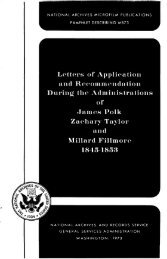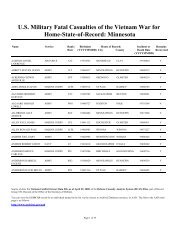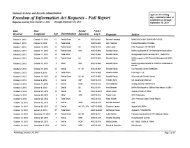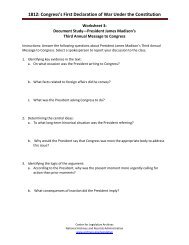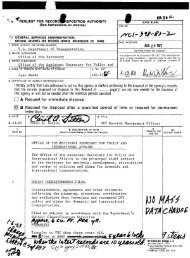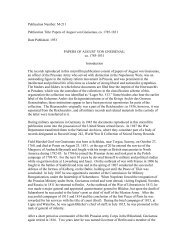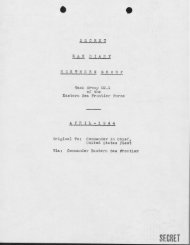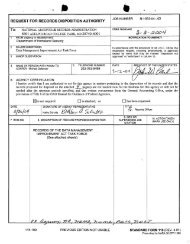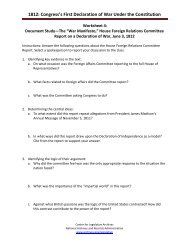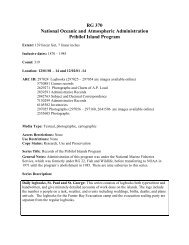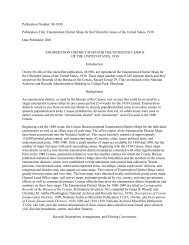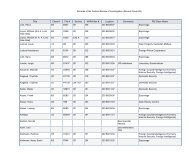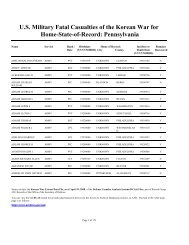HITLER'S SHADOW - National Archives and Records Administration
HITLER'S SHADOW - National Archives and Records Administration
HITLER'S SHADOW - National Archives and Records Administration
You also want an ePaper? Increase the reach of your titles
YUMPU automatically turns print PDFs into web optimized ePapers that Google loves.
September 1941 Kaufmann became the first city official to deport Jews to occupied<br />
Pol<strong>and</strong>. He protected himself after the war with the myth that he opposed the<br />
Gestapo, that he lived a modest life on a modest salary, <strong>and</strong> that he tried to<br />
minimize anti-Jewish measures in Hamburg. The British arrested him in May<br />
1945, but Kaufmann was released for health reasons in October 1948. By 1950 CIC<br />
knew him as a “bad type” who “controls a group of former NSDAP members.” 7<br />
A January 1950 story in the New York Herald Tribune alerted the public to the<br />
Bruderschaft. It painted the Bruderschaft as a shadow general staff that provided<br />
advice to West German Chancellor Konrad Adenauer through Gen. Hasso von<br />
Manteuffel, the Grossdeutschl<strong>and</strong> Division’s comm<strong>and</strong>er for much of 1944 <strong>and</strong><br />
one of Adenauer’s informal advisers on rearmament. Could the Bruderschaft<br />
have signaled that a reconstituted Wehrmacht might overturn the new German<br />
democracy? 8 Though Manteuffel publicly denied Bruderschaft membership<br />
(many sources said he was a member), the press in both Germanys registered<br />
concerns. U.S. High Commissioner John McCloy responded that Allied agents<br />
were studying the group. 9<br />
The CIC began investigating the Bruderschaft in July 1949 with mail intercepts<br />
after learning of a secret meeting in Hamburg. The British shared intelligence from<br />
their zone. They cryptically revealed that Franke-Gricksch was a “high-category<br />
Nazi who was released under certain restrictions” but “failed to live up to the<br />
conditions of his release.” 10 The CIC recruited its own more moderate sources<br />
from within the Bruderschaft. These included Col. Eberhard Graf von Nostitz,<br />
a former staff officer from the 2nd Panzer Army <strong>and</strong> close friend of Manteuffel.<br />
He worked for British intelligence, with a net that included former Foreign Office<br />
<strong>and</strong> Gestapo personnel, <strong>and</strong> also worked for the Gehlen Organization. Though he,<br />
like Manteuffel, denied membership in the Bruderschaft, he maintained frequent<br />
contact with its members <strong>and</strong> attended its meetings. 11<br />
Centered in Hamburg, the Bruderschaft was strongest in the British zone,<br />
but it also had members in the French, U.S., <strong>and</strong> Soviet zones. Its overt aims<br />
were easy to learn, since Beck-Broichsitter spoke with Allied authorities <strong>and</strong> the<br />
press. These aims reflected well-worn army officers’ thinking: anti-Soviet <strong>and</strong><br />
pro-Western policies that also called for the rehabilitation of German soldiers<br />
through restored state pensions <strong>and</strong> the release of officers from war crimes<br />
enclosures. Beck-Broichsitter told U.S. High Commission members that the<br />
The CIC <strong>and</strong> Right-Wing Shadow Politics | 55



